
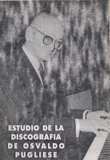
8 controversial recordings
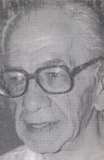
2. Recording details
3. Do they exist ?
4. Searching through modern CD editions.
N.N. - update
5. Conclusion
(enable JavaScript to play the sound samples)
 |
||
 |
8 controversial recordings |
 |
|
2. Recording details 3. Do they exist ? 4. Searching through modern CD editions. N.N. - update 5. Conclusion (enable JavaScript to play the sound samples) |
Nicolas Lefcovich is a well known tango investigator and discographer, unfortunately deceased a few years ago (Sept., 2004). Many of his more extensive works, like the discographies of Francisco Canaro and Roberto Firpo (each several thousands of titles) are unique in its kind. Also, his Pugliese discography is still a classic reference.
In the chronological overview of the recordings by Osvaldo Pugliese, a strange remark can be found when arriving at the end of the year 1952. Eight recordings are involved: the legendary "La Yumba" and also "N.N.", "La Tupungatina", "La Cachila", "Pasional", "Mala Junta", "Barro" and "La Noche Que Me Esperes". All these titles were already mentioned earlier (between 1943, the year when Pugliese started recording with his own orchestra for the Odeon label, and that same year 1952) but about these particular recordings Lefcovich writes the following:
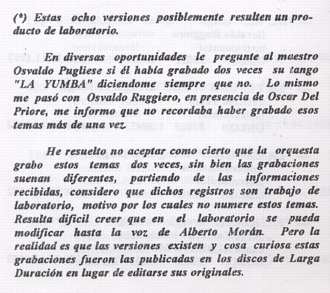 |
"(*) These 8 recordings may be laboratory products. On various occasions I have asked the maestro Osvaldo Pugliese if he had recorded two times his tango "La Yumba" and always he said that he didn't. The same happened with Osvaldo Ruggiero [1], in the presence of Oscar Del Priore [2], he told me that he didn't remember to have recorded these themes more than once. I have decided not to accept as certain that the orchestra recorded these themes two times, although the recordings do sound different. Based on the information that I collected, I concluded that these recordings are the result of laboratory manipulations and consequently I didn't number them [3]. It remains difficult to believe that in a laboratory, even the voice of Alberto Morán could be manipulated. But the truth is that these versions exist and, strangely enough, these recordings were published on long play records, and not the original ones." (from the 1995 edition, but very likely written much earlier) [1] Osvaldo Ruggiero: bandoneonist and
arranger of Pugliese's orchestra (from the 1st orchestra in 1939 until
the formation of the Sexteto Tango in 1968), also composer.
|
When read from a large distance in both
time and space, the rapid jump from an LP edition to a laboratory product
feels rather discomforting, especially with the archaically sounding reference
to a "laboratory".
Nowadays, we live in the age were the
"remastered / remasterizado" label is a selling argument on CD editions
of tango music. This is not the first time in history though : already
in the late fifties and sixties, many of the old 78 rpm records (discos
de pasta) were reedited on vinyl LPs (larga duración, vinilo).
As
can be seen in the following citation, taken from such a reedition (in
this case of Carlos Di Sarli with Roberto Rufino, and for another label,
RCA Víctor) sound improvement and error corrections were already
used. Interestingly, the same term "laboratory" also occurs. Now that we
have our PCs loaded with all kinds of sound editing software, it may seem
unusual to us, it certainly wasn't in those days.
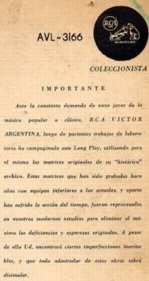
Enlarge |
"IMPORTANT Because of the constant demand for these jewels of popular and classical music, RCA VICTOR ARGENTINA, as a result of patient work in the laboratory, has composed this Long Play using the original masters from its historical archive [1]. These masters were recorded some years ago [2] with equipment, inferior to the one that is now available, and moreover, suffered from the action of time. They were reprocessed in our modern studios to eliminate deficiencies and original shortcomings. Nevertheless you will still encounter certain inevitable imperfections which every admirer will be able to ignore." [1] This text was very likely published
in 1960, maybe one year earlier. Just a few years later a considerable
part of this "historical archive" will be deliberately destroyed.
|
Now that the Lefcovich statement becomes
a little bit more acceptable, the question arises : does it still hold
?
But first the details of the recordings...
In the following table, the data of the
"first recordings" are juxtaposed to those of the alledged "second recordings",
all as given by Lefcovich. In the right-most column, I have also added
2 titles ("El Embrollo" and "Manos Adoradas") which were recorded in the
same period (not questioned by Lefcovich), they are not "second recordings"
but chronologically they belong there. The acoples, the accompanying
titles on the same record, are inferred from the record numbers as given.
| Title, authors
and,
optionally, vocalist |
(Date - Record number - Master number - Acople) See also: Short note on tango record identification |
(Date - Record number - Master number - Acople) See also: Short note on tango record identification |
| El Embrollo
(Esteban Enrique Gilardi) |
|
55500 18705 (Manos Adoradas - with A. Morán) |
| La Yumba
(Osvaldo Pugliese) |
7686 15758 (Mal de Amores - instr) |
55521 18758/1 (N.N. - instr) |
| N.N.
(Osvaldo Ruggiero) |
7691 16421 (Desilusión - with A. Morán) |
55521 16421/1 (La Yumba - instr) |
| La Tupungatina
(Christino Tapia) |
55425 18452 (Ahora No Me Conoces - with A. Morán) |
55425 18452/1 (???) |
| La Cachila
(Eduardo Arolas) |
7677 14937 (Mentira - with A. Morán) |
55565 14937/1 (Pasional) |
| Pasional
(Jorge Caldara - Mario Soto) with Alberto Morán |
55280 18137 (Bien Milonga - instr) |
55655 17137/1 (La Cachila) |
| Mala Junta
(Julio De Caro - Pedro Laurenz - J.M. Velich) |
7661 13082 (Muchachos Comienzo La Ronda - with R. Chanel) |
55539 13082/1 (Barro - with A. Morán) |
| Barro
(Osvaldo Pugliese - Horacio Basterra) with Alberto Morán |
55243 18024 (De Vuelta Al Bulín - with A. Morán) |
55539 18024/1 (Mala Junta - instr) |
| La Noche Que Me Esperes
(Juan Canaro) with Alberto Morán |
55372 18339 (Cualquier Cosa - with A. Morán) |
55372 18939/1 (???) |
| Manos Adoradas
(Roberto Rufino - Horacio Sanguinetti) with Alberto Morán |
|
55500 18714 (El Embrollo - instr) |
| Obviously, Lefcovich felt somehow lost
with these recordings. The master numbers were just copied from the original
recording with "/1" appended, the conventional indication for a "take-2"
recording. The differences (15758 vs. 18758/1, 18137 vs. 17137/1 and 18339
vs. 18939/1) have the appearance of transcription errors. This is not a
regular feature in the work of Lefcovich but could have been caused by
the decoupling of master number and recording date, making it more difficult
to spot errors.
On the other hand, Lefcovich must have had access to documents which provided recording dates and record numbers. These numbers sometimes come pair-wise, indicating regular 78 rpm records, contrasting with the "long playings" mentioned in his comment. And yet, Lefcovich concludes that these recordings may not exist. These observations should not be understood
as a depreciation of the work of Lefcovich, on the contrary. They show
that Lefcovich, in spite of a few printing errors that slipped through,
was very keen on checking the factual basis of his data, preferring a possible
omission over the creation of a chimerical recording.
|
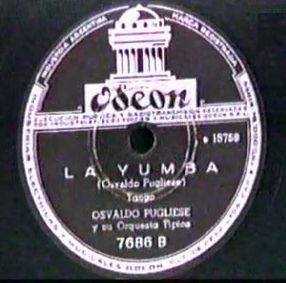 |
Lefcovich acknowledges the fact that some editions exist that do "sound different". Could they really be rerecordings ?
A first observation is that Pugliese, unlike others (Di Sarli, Sassone, Canaro, D'Arienzo...), did not record very often the same title twice. Not counting the live recordings (like the Teatro Colón concert in 1985) and the titles discussed here, there are only some ten cases. Not much in a repertory of more than 400 recordings, but they show that the fact cannot be excluded in principle.
"Los Grandes del Tango" devoted an issue to Pugliese (N°7, December, 1990). However charming these booklets are (more than 100 appeared between 1990 and 1993, each about 20 to 40 pages), their discographies are not among the most reliable and complete. In the Pugliese discography they mention only single recordings for "La Noche Que Me Esperes" and "La Tupungatina" in 1952 but they do list "La Yumba" and "N.N." in that year. "Barro" and "Pasional" are mentioned in 1951, but not in 1952, neither are "La Cachila" and "Mala Junta".
The Buenos Aires Tango Club published the second part of the Pugliese discography (from May, 1952 on) in the Revista del Buenos Aires Tango Club N°7 (July, 1999). None of the Lefcovich duplicados is mentioned.
On Todo Tango, recognizing Lefcovich as a source, the 8 recordings are listed, with the same details as given above but they ommit the Lefcovich comment. Because it didn't fit into their tabular format ? On the other hand, among their sound samples ("La música") both "La Yumba" and "N.N." are identified (by date and numbers) as the second recordings.
Interestingly, Roberto G. Miglio, in his discography of Alberto Morán (El Tango y Sus Intérpretes - Vol.2), mentions for each of "Pasional", "Barro" and "La Noche Que Me Esperes" the two recordings. In the case of "Pasional", the double recording not only occurs in the listing but is also explicitly mentioned in the short biography that preceedes it.

But most fascinating is a communication by Oscar Del Priore (already called as a witness by Lefcovich himself !) which was transmitted through the Cueva de Tango at the end of 2003. He assured that these titles were indeed recorded twice and added that Pugliese took the opportunity to work with the new recording technologies that had become available (magnetic tapes - until that time, music was recorded directly onto the master disk, in the early fifties magnetic tape became available as the first recording medium, which was then transferred onto the master disk in a second step).
Different opinions... I guess that
only Odeon documents, if they exist, could settle the case. Apparently,
some of the editions "which sound different" have made it on to CD and
from what I hear I feel tempted to consider some of them indeed as different
recordings. Would it be logical to think that some technician tries to
improve Pugliese, turning knobs and dials to insert fragments or modify
parts, instead of being a musician himself? Moreover, I think that Lefcovich
overestimated the capabilities of sound engineers at that time.
|
|
Nicolas Lefcovich 16-06-2006 (updated 08-2007) Part 2 |
|
|